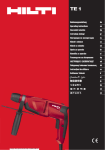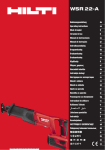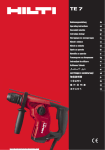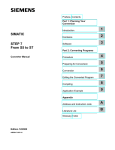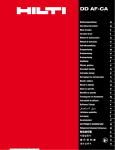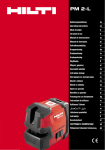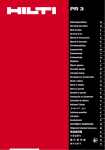Download Hilti SFC 22-A cordless combi drill
Transcript
SFC22-A/ SFC 14-A Operating instructions Mode d’emploi Brugsanvisning Bruksanvisning Bruksanvisning Käyttöohje Инструкция по зксплуатации Kulllanma Talimatı Lietošanas pamācība Instrukcija Kasutusjuhend IНСТРУКЦIЯ З ЕКСПЛУАТАЦIЇ Пайдалану бойынша басшылық Printed: 30.09.2013 | Doc-Nr: PUB / 5152681 / 000 / 01 en fr da sv no fi ru tr ar lv lt et uk kk ja ko zh cn 1 ꛈ ꛉ ꛋ ꛌ SFC 14-A ꛊ ꛎ ꛍ ꛑ ꛏ ꛐ ꛏ ꛐ ꛈ SFC 22-A ꛉ ꛋ ꛌ ꛊ ꛎ ꛍ ꛑ ꛐ ꛏ Printed: 30.09.2013 | Doc-Nr: PUB / 5152681 / 000 / 01 ꛐ ꛏ 2 3 4 5 6 Printed: 30.09.2013 | Doc-Nr: PUB / 5152681 / 000 / 01 7 8 9 Printed: 30.09.2013 | Doc-Nr: PUB / 5152681 / 000 / 01 ORIGINAL OPERATING INSTRUCTIONS SFC 22-A/SFC 14A cordless drill / driver It is essential that the operating instructions are read before the power tool is operated for the first time. Always keep these operating instructions together with the power tool. Ensure that the operating instructions are with the power tool when it is given to other persons. Contents 1 General information 3 Insert tools, accessories 2 4 5 6 7 8 . . . . . . . . . . . . . . . . . . . . . Description . . . . . . . . . . . . . . . . . . . . . . . . . . . 1 2 . . . . . . . . . . . . . . . . . . 3 Safety instructions . . . . . . . . . . . . . . . . . . . . . . 5 Technical data . . . . . . . . . . . . . . . . . . . . . . . . . Before use . . . . . . . . . . . . . . . . . . . . . . . . . . . . Operation . . . . . . . . . . . . . . . . . . . . . . . . . . . 4 9 10 Care and maintenance . . . . . . . . . . . . . . . . . . . 11 10 Disposal . . . . . . . . . . . . . . . . . . . . . . . . . . . . 13 12 EC declaration of conformity (original) . . . . . . . . 9 11 Troubleshooting . . . . . . . . . . . . . . . . . . . . . . . Manufacturer’s warranty - tools . . . . . . . . . . . . . 12 14 14 1 These numbers refer to the corresponding illustrations. The illustrations can be found on the fold-out cover pages. Keep these pages open while studying the operating instructions. In these operating instructions, the designation “power tool” always refers to the SFC 22-A or SFC 14-A cordless combination drill, with battery fitted. Parts, operating controls and indicators 1 @ ; = % & ( ) + Keyless chuck Torque and drilling mode setting ring Control switch (with electronic speed control) Forward / reverse switch 2-speed gear selector switch Lamp Grip Release buttons with additional function (charge status display activation) § Charge status and fault display (Li-ion battery) / Belt hook (optional) 1 General information 1.1 Safety notices and their meaning DANGER Draws attention to imminent danger that will lead to serious bodily injury or fatality. WARNING Draws attention to a potentially dangerous situation that could lead to serious personal injury or fatality. CAUTION Draws attention to a potentially dangerous situation that could lead to slight personal injury or damage to the equipment or other property. NOTE Draws attention to an instruction or other useful information. 1 Printed: 30.09.2013 | Doc-Nr: PUB / 5152681 / 000 / 01 en 1.2 Explanation of the pictograms and other information Warning signs en General warning Warning: electricity Warning: caustic substances Wear a hard hat Wear ear protection Wear protective gloves Read the operating instructions before use Volts Direct current Rated speed under no load Revolutions per minute Drilling without hammering Return waste material for recycling. Obligation signs Wear eye protection Wear breathing protection Symbols Location of identification data on the power tool The type designation can be found on the type identification plate at the base of the power tool and the serial number on the side of the casing. Make a note of this data in your operating instructions and always refer to it when making an enquiry to your Hilti representative or service department. Type: Generation: 01 Serial no.: 2 Description 2.1 Use of the product as directed The SFC 22A or SFC 14A is a hand-held, battery powered combination drill for screwing and unscrewing screws and for drilling in steel, wood and plastic. Working on materials hazardous to the health (e.g. asbestos) is not permissible. Do not use the battery as a power source for other unspecified appliances. Modification of the power tool or tampering with its parts is not permissible. To avoid the risk of injury, use only genuine Hilti accessories and insert tools. Observe the information printed in the operating instructions concerning operation, care and maintenance. The power tool is designed for professional use and may be operated, serviced and maintained only by trained, authorized personnel. This personnel must be informed of any special hazards that may be encountered. The power tool and its ancillary equipment may present hazards when used incorrectly by untrained personnel or when used not as directed. 2 Printed: 30.09.2013 | Doc-Nr: PUB / 5152681 / 000 / 01 The working environment may be as follows: construction site, workshop, renovation, conversion or new construction. 2.2 Chuck Keyless chuck en 2.3 Switches Control switch with electronic speed control 2-speed gear selector switch Forward / reverse selector switch with safety lock Torque and drilling mode setting ring 2.4 Grips Vibration-absorbing grip 2.5 Lubrication Grease lubrication 2.6 The items supplied include (toolbox versions): 1 Power tool 1 Operating instructions 1 Hilti toolbox 2.7 The items supplied include (cardboard box versions): 1 Power tool 1 Operating instructions 2.8 Additional items required for operating the tool B 22/1.6 LiIon, B 22/2.6 LiIon, B 22⁄3.3 LiIon, B 14/1.6 LiIon or B 14/3.3 LiIon battery with C4⁄3690, C4⁄36350, C 4/36, C 4/36ACS or C 4/36ACS TPS charger. 2.9 Li-ion battery charge status and overheating indicator LEDs light constantly LEDs blink Charge status C LED 1, 2, 3, 4 - C ≧ 75 % LED 1, 2, 3 - 50 % ≦ C < 75 % LED 1, 2 - 25 % ≦ C < 50 % LED 1 - 10 % ≦ C < 25 % - LED 1 C < 10 % - LED 1 Battery overheated 2.10 Overload and overheating protection The power tool is equipped with an electronic protection system to prevent overloading and overheating. The power tool switches itself off automatically in the event of overloading and overheating. After releasing the control switch, the power tool may not restart immediately when the switch is pressed again (while the power tool is cooling down). 3 Insert tools, accessories Designation Short designation Charger for Li-ion batteries C 4/36 Charger for Li-ion batteries C 4/36ACS Charger for Li-ion batteries C 4/36-ACS TPS Charger for Li-ion batteries C 4/3690 Charger for Li-ion batteries C 4/36350 Battery B 22/1.6 LiIon Battery B 22/2.6 LiIon Battery B 22/3.3 LiIon Battery B 14/1.6 LiIon Bit holder S-BH 50 3 Printed: 30.09.2013 | Doc-Nr: PUB / 5152681 / 000 / 01 Designation Short designation Battery B 14/3.3 LiIon Belt hook (optional) en Designation Description Keyless chuck clamping range ∅ 1.5…13 mm Drilling diameter range in wood ∅ 1.5…20 mm (soft) Drilling diameter range in wood ∅ 1.5…12 mm (hard) Drilling diameter range in metal ∅ 1.5…10 mm Wood screws (max. length 80 mm) Driving screws in plastic anchors (max. length 120 mm) ∅ 3…6 mm ∅ Max. 8 mm 4 Technical data Right of technical changes reserved. Power tool SFC 14A SFC 22A Rated voltage (DC voltage) 14.4 V 21.6 V Weight in accordance with EPTA procedure 01/2003 1.5 kg 1.7 kg Dimensions (L x W x H with B 14/1.6 or B 22/1.6) 192 mm x 80 mm x 225 mm 202 mm x 92 mm x 234 mm 1st gear speed (with B 14/3.3 or B 22/2.6) 0…500/min 0…600/min 2nd gear speed (with B 14/3.3 or B 22/2.6) 0…1,700/min 0…1,800/min Torque with tool set to drilling symbol (soft/flexible joint) Max. 24 Nm Max. 28 Nm Torque range (15 settings) 1.5…10 Nm 1.5…10 Nm NOTE The vibration emission level given in this information sheet has been measured in accordance with a standardized test given in EN 60745 and may be used to compare one tool with another. It may be used for a preliminary assessment of exposure. The declared vibration emission level represents the main applications of the tool. However if the tool is used for different applications, with different accessories or poorly maintained, the vibration emission may differ. This may significantly increase the exposure level over the total working period. An estimation of the level of exposure to vibration should also take into account the times when the tool is switched off or when it is running but not actually doing the job. This may significantly reduce the exposure level over the total working period. Identify additional safety measures to protect the operator from the effects of vibration such as: maintain the tool and the accessories, keep the hands warm, organization of work patterns. Noise and vibration information (measured in accordance with EN 60745): Typical A-weighted sound power level for the SFC 22-A 80 dB (A) Typical A-weighted emission sound pressure level for the SFC 22-A. 69 dB (A) Typical A-weighted sound power level for the SFC 14-A 80 dB (A) 4 Printed: 30.09.2013 | Doc-Nr: PUB / 5152681 / 000 / 01 Typical A-weighted emission sound pressure level for the SFC 14-A. 69 dB (A) Triaxial vibration values (vibration vector sum) measured in accordance with EN 6074522 Uncertainty for the given sound 3 dB (A) level en For the SFC 22A: Screwdriving 1 m/s² without impact action, ah For the SFC 14A: Screwdriving 1 m/s² without impact action, ah Uncertainty (K) 1.5 m/s² Triaxial vibration values (vibration vector sum) measured in accordance with EN 6074521 For the SFC 14A: Drilling in metal, ah,D 2.0 m/s² For the SFC 22A: Drilling in metal, ah,D 2.0 m/s² Uncertainty (K) for triaxial vibra- 1.5 m/s² tion measurements Battery B 14/1.6 LiIon B 14/3.3 LiIon Rated voltage 14.4 V 14.4 V Capacity 1.6 Ah 3.3 Ah Energy content 23.04 Wh 47.52 Wh Weight 0.36 kg 0.60 kg Temperature monitoring Yes Yes Type of cell Li-ion Li-ion No. of cells 4 8 B 22/1.6 LiIon B 22/2.6 LiIon B 22/3.3 LiIon Capacity 1.6 Ah 2.6 Ah 3.3 Ah Energy content 34.56 Wh 56.16 Wh 71.28 Wh Weight 0.48 kg 0.78 kg 0.78 kg Temperature monitoring Yes Yes Yes Type of cell Li-ion Li-ion Li-ion No. of cells 6 12 12 Battery Rated voltage 21.6 V 21.6 V 21.6 V 5 Safety instructions NOTE The safety rules in section 5.1 contain all general safety rules for power tools which, in accordance with the applicable standards, must be listed in the operating instructions. Accordingly, some of the rules listed may not be relevant to this tool. 5.1 General power tool safety warnings a) WARNING Read all safety warnings and all instructions. Failure to follow the warnings and instructions may result in electric shock, fire and/or serious injury. Save all warnings and instructions for future reference. The term “power tool” in the warnings refers to your mains-operated (corded) power tool or battery-operated (cordless) power tool. 5.1.1 Work area safety a) Keep work area clean and well lit. Cluttered or dark areas invite accidents. b) Do not operate power tools in explosive atmospheres, such as in the presence of flammable liquids, gases or dust. Power tools create sparks which may ignite the dust or fumes. 5 Printed: 30.09.2013 | Doc-Nr: PUB / 5152681 / 000 / 01 c) Keep children and bystanders away while operating a power tool. Distractions can cause you to lose control. 5.1.2 Electrical safety a) Power tool plugs must match the outlet. Never modify the en plug in any way. Do not use any adapter plugs with earthed (grounded) power tools. Unmodified plugs and matching outlets will reduce risk of electric shock. b) Avoid body contact with earthed or grounded surfaces, such as pipes, radiators, ranges and refrigerators. There is an increased risk of electric shock if your body is earthed or grounded. c) Do not expose power tools to rain or wet conditions. Water entering a power tool will increase the risk of electric shock. d) Do not abuse the cord. Never use the cord for carrying, pulling or unplugging the power tool. Keep cord away from heat, oil, sharp edges or moving parts. Damaged or entangled cords increase the risk of electric shock. e) When operating a power tool outdoors, use an extension cord suitable for outdoor use. Use of a cord suitable for outdoor use reduces the risk of electric shock. f) If operating a power tool in a damp location is unavoidable, use a residual current device (RCD) protected supply. Use of an RCD reduces the risk of electric shock. 5.1.3 Personal safety a) Stay alert, watch what you are doing and use common sense when operating a power tool. Do not use a power tool while you are tired or under the influence of drugs, alcohol or medication. A moment of inattention while operating power tools may result in serious personal injury. b) Use personal protective equipment. Always wear eye protection. Protective equipment such as dust mask, nonskid safety shoes, hard hat, or hearing protection used for appropriate conditions will reduce personal injuries. c) Prevent unintentional starting. Ensure the switch is in the off‐position before connecting to power source and/or battery pack, picking up or carrying the tool. Carrying power tools with your finger on the switch or energising power tools that have the switch on invites accidents. d) Remove any adjusting key or wrench before turning the power tool on. A wrench or a key left attached to a rotating part of the power tool may result in personal injury. e) Do not overreach. Keep proper footing and balance at all times. This enables better control of the power tool in unexpected situations. f) Dress properly. Do not wear loose clothing or jewellery. Keep your hair, clothing and gloves away from moving parts. Loose clothes, jewellery or long hair can be caught in moving parts. g) If devices are provided for the connection of dust extraction and collection facilities, ensure these are connected and properly used. Use of dust collection can reduce dust-related hazards. 5.1.4 Power tool use and care a) Do not force the power tool. Use the correct power tool for your application. The correct power tool will do the job better and safer at the rate for which it was designed. b) Do not use the power tool if the switch does not turn it on and off. Any power tool that cannot be controlled with the switch is dangerous and must be repaired. c) Disconnect the plug from the power source and/or the battery pack from the power tool before making any adjustments, changing accessories, or storing power tools. Such preventive safety measures reduce the risk of starting the power tool accidentally. d) Store idle power tools out of the reach of children and do not allow persons unfamiliar with the power tool or these instructions to operate the power tool. Power tools are dangerous in the hands of untrained users. e) Maintain power tools. Check for misalignment or binding of moving parts, breakage of parts and any other condition that may affect the power tool’s operation. If damaged, have the power tool repaired before use. Many accidents are caused by poorly maintained power tools. 6 Printed: 30.09.2013 | Doc-Nr: PUB / 5152681 / 000 / 01 Keep cutting tools sharp and clean. Properly maintained cutting tools with sharp cutting edges are less likely to bind and are easier to control. g) Use the power tool, accessories and tool bits etc. in accordance with these instructions, taking into account the working conditions and the work to be performed. Use en of the power tool for operations different from those intended could result in a hazardous situation. f) 5.1.5 Battery tool use and care a) Recharge only with the charger specified by the manufacturer. A charger that is suitable for one type of battery pack may create a risk of fire when used with another battery pack. b) Use power tools only with specifically designated battery packs. Use of any other battery packs may create a risk of injury and fire. c) When battery pack is not in use, keep it away from other metal objects, like paper clips, coins, keys, nails, screws or other small metal objects, that can make a connection from one terminal to another. Shorting the battery terminals together may cause burns or a fire. d) Under abusive conditions, liquid may be ejected from the battery; avoid contact. If contact accidentally occurs, flush with water. If liquid contacts eyes, additionally seek medical help. Liquid ejected from the battery may cause irritation or burns. 5.1.6 Service a) Have your power tool serviced by a qualified repair person using only identical replacement parts. This will ensure that the safety of the power tool is maintained. 5.2 Drill safety warnings a) Wear ear protectors when impact drilling. Exposure to noise can cause hearing loss. b) Use auxiliary handle(s), if supplied with the tool. Loss of control can cause personal injury. c) Hold power tool by insulated gripping surfaces, when performing an operation where the cutting accessory may contact hidden wiring. Cutting accessory contacting a "live" wire may make exposed metal parts of the power tool "live" and could give the operator an electric shock. 5.3 Additional safety precautions 5.3.1 Personal safety a) Hold power tool by insulated gripping surfaces, when performing an operation where the fastener may contact hidden wiring. Fasteners contacting a "live" wire may make exposed metal parts of the power tool "live" and could give the operator an electric shock. b) Always hold the power tool securely with both hands on the grips provided. Keep the grips dry, clean and free from oil and grease. c) Improve the blood circulation in your fingers by relaxing your hands and exercising your fingers during breaks between working. d) Avoid touching rotating parts. Switch the power tool on only after bringing it into position at the workpiece. Touching rotating parts, especially rotating insert tools, may lead to injury. e) Activate the safety lock (forward / reverse switch in the middle position) before storing or transporting the power tool. f) The power tool is not intended for use by children, by debilitated persons or those who have received no instruction or training. g) Children must be instructed not to play with the power tool. h) Dust from material such as paint containing lead, some wood species, minerals and metal may be harmful. Contact with or inhalation of the dust may cause allergic reactions and/or respiratory diseases to the operator or bystanders. Certain kinds of dust are classified as carcinogenic such as oak and beech dust especially in conjunction with additives for wood conditioning (chromate, wood preservative). Material containing asbestos must only be treated by specialists. Where the use of a dust extraction device is possible it shall be used. 7 Printed: 30.09.2013 | Doc-Nr: PUB / 5152681 / 000 / 01 To achieve a high level of dust collection, use a suitable vacuum cleaner of the type recommended by Hilti for wood dust and/or mineral dust together with this tool. Ensure that the workplace is well ventilated. The use of a dust mask of filter class P2 is recommended. Follow national requirements for the materials you want to work with. en 5.3.2 Power tool use and care a) Secure the workpiece. Use clamps or a vice to secure the workpiece. The workpiece is thus held more securely than by hand and both hands remain free to operate the power tool. b) Check that the insert tools used are compatible with the chuck system and that they are secured in the chuck correctly. c) Large and heavy insert tools must only be operated in first gear. There is otherwise a risk that the tool will be damaged when it is switched off or, under unfavorable conditions, the chuck might be detached. 5.3.3 Cordless tool use and care a) Ensure the switch is in the off position before inserting battery pack. Inserting the battery pack into power tools that have the switch on invites accidents. b) Do not expose batteries to high temperatures or fire. This presents a risk of explosion. c) Do not disassemble, squash or incinerate batteries and do not subject them to temperatures over 80°C. A risk of fire, explosion or injury through contact with caustic substances may otherwise result. d) Avoid ingress of dampness.Dampness may cause a short circuit resulting in a risk of burning injury or fire. e) Do not use batteries other than those approved for use with the applicable power tool or appliance. Use of other batteries or use of the battery for purposes for which it is not intended presents a risk of fire and explosion. f) Observe the special instructions applicable to the transport, storage and use of Li-ion batteries. g) Remove the battery before storing or transporting the power tool. h) Avoid short-circuiting the battery. Check that the terminals on the battery and in the power tool are free from foreign objects before inserting the battery in the power tool. Short circuiting the battery terminals presents a risk of fire, explosion and chemical burns. i) Do not charge or continue to use damaged batteries (e.g. batteries with cracks, broken parts, bent or pushed-in and/or pulled-out contacts). j) If the battery gets too hot to touch, this may indicate that it is faulty. Place the tool in a location where it can be kept under observation, well away from flammable materials, and allow it to cool down. Contact Hilti Service after the battery has been allowed to cool. 5.3.4 Electrical safety Before beginning work, check the working area (e.g. using a metal detector) to ensure that no concealed electric cables or gas and water pipes are present. External metal parts of the power tool may become live, for example, when an electric cable is damaged accidentally. This presents a serious risk of electric shock. 5.3.5 Work area safety a) Ensure that the workplace is well lit. b) Ensure that the workplace is well ventilated. Exposure to dust at a poorly ventilated workplace may result in damage to the health. 8 Printed: 30.09.2013 | Doc-Nr: PUB / 5152681 / 000 / 01 5.3.6 Personal protective equipment en The user and any other persons in the vicinity must wear suitable eye protection, a hard hat, ear protection, protective gloves and breathing protection while the tool is in use. 6 Before use 6.1 Battery use and care NOTE Battery performance drops at low temperatures. Use a battery only when it has been fully charged. This ensures that maximum battery capacity is available. Change to the second battery as soon as a drop in performance is noticed. Recharge the battery immediately so that it is ready for reuse. Store the battery in a cool, dry place. Never store the battery where it is exposed to direct sunlight or sources of heat, e.g. on heaters / radiators or behind a motor vehicle windscreen. Batteries that have reached the end of their life must be disposed of safely and correctly to avoid environmental pollution. 6.2 Charging the battery DANGER Use only the Hilti batteries and Hilti chargers listed under “Accessories”. 6.2.1 Charging a new battery for the first time Charge the battery fully before using it for the first time. 6.2.2 Charging a previously used battery Ensure that the outer surfaces of the battery are clean and dry before inserting it in the corresponding charger. Read the operating instructions for the charger for further information about the charging procedure. Li-ion batteries are ready for use at any time, even when only partly charged. Charging progress is indicated by the LED display (see charger operating instructions). 6.3 Fitting the battery CAUTION Before fitting the battery, check that the power tool is switched off and that the safety lock is engaged (forward/reverse switch in the middle position). Use only the Hilti batteries approved for use with this power tool. CAUTION Check that the terminals on the battery and in the power tool are free from foreign objects before inserting the battery in the power tool. 1. Push the battery into the power tool from the rear as far as it will go and until it is heard to engage with a double click. 2. CAUTION A falling battery may present a risk of injury to yourself or others. Check that the battery is seated securely in the power tool. 9 Printed: 30.09.2013 | Doc-Nr: PUB / 5152681 / 000 / 01 6.4 Removing the battery 2 1. Press one or both release buttons. 2. Pull the battery out of the power tool toward the rear. en 6.5 Transport and storage of battery packs Pull the battery pack out of the locked position (working position) and move it into the first click-stop position (transport position). If you disconnect a battery pack from the power tool for transport or storage, make sure that the contacts of the battery pack are not short-circuited. Remove loose metal parts such as screws, nails, clamps, loose screw bits, wires or metal swarf from the case, toolbox or transport container, or prevent these parts from coming into contact with the battery packs. Observe national and international transport regulations when shipping battery packs (transportation by road, rail, sea or air). 6.6 Belt hook 3 CAUTION Check that the belt hook is fitted securely before beginning work. The belt hook allows the power tool to be attached to a belt worn by the operator. The belt hook can also be fitted to the other side of the power tool for use by left-handed persons. 1. Pull the battery out of the tool. 2. Fit the mounting plate into the guides provided. 3. Secure the belt hook with the two screws. 7 Operation CAUTION The tool may get hot during use. Wear protective gloves. CAUTION When drilling and screwdriving, the grip of the tool may be deflected laterally (the tool tends to pivot about its own axis). CAUTION To avoid injuries caused by the insert tool, wear protective gloves when changing insert tools. 7.1 Setting forward or reverse rotation 4 NOTE The forward / reverse switch is used to select the direction of rotation of the drive spindle. An interlock prevents switching while the motor is running. The control switch is locked when the forward / reverse switch is in the middle position. Push the forward / reverse switch to the right (power tool held in working direction) to select forward rotation. Push the forward / reverse switch to the left (power tool held in working direction) to select reverse rotation. 7.2 Speed selection using the 2-speed gear switch 5 WARNING Large and heavy insert tools must only be operated in first gear. There is otherwise a risk that the tool will be damaged when it is switched off or, under unfavorable conditions, the chuck might be detached. NOTE The mechanical 2-speed gear switch can be used to select the speed range required. Speed with fully-charged battery: SFC 14A: 1st gear: 0500 /min., 2nd gear: 01700 /min. SFC 22A: 1st gear: 0600 /min., 2nd gear: 01800 /min. 7.3 Switching on / off Speed of rotation can be controlled smoothly up to maximum speed by pressing the control switch slowly. 7.4 Fitting the drill bit 1. Set the forward / reverse switch to the middle position or remove the battery from the power tool. 10 Printed: 30.09.2013 | Doc-Nr: PUB / 5152681 / 000 / 01 2. Check that the connection end of the drill bit is clean. Clean the connection end if necessary. 3. Insert the drill bit in the keyless chuck and then turn the chuck firmly by hand until several clicks are heard. 4. Check that the drill bit is held securely. 7.5 Removing the drill bit 1. Set the forward / reverse switch to the middle position or remove the battery from the power tool. 2. Open the keyless chuck. 3. Pull the insert tool out of the chuck. 7.6 Drilling CAUTION Use clamps or a vice to secure the workpiece. The workpiece is thus held more securely than by hand and both hands remain free to operate the power tool. 1. Turn the torque and operating mode setting ring to the drilling symbol. 2. Move the forward / reverse switch to the “Forward” position. 7.7 Screwdriving 7.7.1 Fitting the bit holder / bit 1. Set the forward / reverse switch to the middle position or remove the battery from the power tool. 2. Open the quick-release chuck. 3. Insert the bit adapter in the keyless chuck and then turn the chuck firmly by hand until tight. 4. Check that the bit adapter is held securely (check by pulling). 5. Fit the bit in the bit holder. 7.7.2 Screwdriving 1. Select the torque function on the setting ring for torque and drilling. 2. Set the forward / reverse switch to the desired direction of rotation. 7.7.3 Removing the bit / bit holder 1. Set the forward / reverse switch to the middle position or remove the battery from the power tool. 2. Remove the bit from the bit holder. 3. Open the keyless chuck. 4. Remove the bit adapter. 7.8 Reading the charge status LED display on Liion batteries 6 NOTE The charge status can not be indicated while the power tool is in operation. LED 1 blinks when the battery is fully discharged or when it is too hot (temperature above 80°C). The battery must then be inserted in the charger. The Li-ion battery features a charge status LED display. The charge status is indicated by the LEDs on the battery during charging (please refer to the operating instructions for the charger). When the battery is not in use, pressing one of the battery release buttons or inserting the battery into the power tool causes the battery charge status to be displayed by the four LEDs for three seconds. 8 Care and maintenance CAUTION Before beginning cleaning, remove the battery from the power tool in order to prevent unintentional starting. 8.1 Care of insert tools Clean off dirt and dust deposits adhering to the insert tools and protect them from corrosion by wiping the insert tools from time to time with an oil-soaked rag. 11 Printed: 30.09.2013 | Doc-Nr: PUB / 5152681 / 000 / 01 en 8.2 Care of the power tool CAUTION Keep the power tool, especially its grip surfaces, clean and free from oil and grease. Do not use cleaning agents which en contain silicone. The outer casing of the power tool is made from impact-resistant plastic. Sections of the grip are made from a synthetic rubber material. Never operate the power tool when the ventilation slots are blocked. Clean the ventilation slots carefully using a dry brush. Do not permit foreign objects to enter the interior of the power tool. Clean the outside of the power tool at regular intervals with a slightly damp cloth. Do not use a spray, steam pressure cleaning equipment or running water for cleaning. This may negatively affect the electrical safety of the power tool. 8.3 Care of the Li-ion battery Avoid entrance of moisture. Charge the battery fully before using it for the first time. In order to achieve maximum battery life, stop discharging the battery as soon as a significant drop in performance is noticed. NOTE If use of the power tool continues, battery discharge is stopped automatically (indicated by LED 1 blinking) before the battery cells suffer damage. Charge the battery with the Hilti charger approved for use with Li-ion batteries. NOTE – A conditioning charge (as is required with NiCd or NiMH batteries) is not necessary. – Interruption of the charging procedure has no negative effect on battery life. – Charging can be started at any time with no negative effect on battery life. There is no memory effect (as with NiCd or NiMH batteries). – For best results, batteries should be stored fully charged in a cool dry place. Avoid charging the battery in places subject to high ambient temperatures (e.g. at a window) as this has an adverse effect on battery life and increases the rate of self-discharge. – If the battery no longer reaches full charge, it may have lost capacity due to aging or overstressing. It is possible to continue working with a battery in this condition but it should be replaced in good time. 8.4 Maintenance WARNING Repairs to the electrical section of the power tool may be carried out only by trained electrical specialists. Check all external parts of the power tool for damage at regular intervals and check that all controls operate faultlessly. Do not operate the power tool if parts are damaged or when the controls do not function faultlessly. If necessary, the power tool should be repaired by Hilti Service. 8.5 Checking the power tool after care and maintenance After carrying out care and maintenance work on the power tool, check that all protective and safety devices are fitted and that they function faultlessly. 9 Troubleshooting Fault Possible cause Remedy The power tool doesn’t run. The battery is discharged or fitted incorrectly. The battery must be heard to engage with a double click or, respectively, needs to be charged. Electrical fault. 12 Printed: 30.09.2013 | Doc-Nr: PUB / 5152681 / 000 / 01 Remove the battery from the power tool and contact Hilti Service. Fault Possible cause Remedy The power tool The battery is disdoesn’t run and 1 charged. LED blinks. Change the battery and recharge the discharged battery. The on / off switch can’t be pressed, i.e. the switch is locked. Push the forward / reverse switch to the left or right. The battery is too hot Bring the battery to or too cold. the recommended working temperature. The forward / reverse switch is in the middle position (transport lock engaged). The battery runs Battery condition is down more not optimal. quickly than usual. The battery does- The retaining lugs on n’t engage with the battery are dirty. an audible double click. LED 1 blinks. The battery is discharged. The tool is overloaded (application limits exceeded). Have battery condition diagnosed by Hilti Service or replace with a new battery. Clean the retaining lugs and check that the battery engages securely. Contact Hilti Service if the problem persists. Charge the battery. Use the right power tool for the job (don’t use a low-powered tool for heavy work). 10 Disposal CAUTION Improper disposal of the equipment may have serious consequences: the burning of plastic components generates toxic fumes which may present a health hazard. Batteries may explode if damaged or exposed to very high temperatures, causing poisoning, burns, acid burns or environmental pollution. Careless disposal may permit unauthorized and improper use of the equipment. This may result in serious personal injury, injury to third parties and pollution of the environment. CAUTION Dispose of defective batteries without delay. Keep them out of reach of children. Do not attempt to open or dismantle batteries and do not dispose of them by incineration. CAUTION Dispose of the batteries in accordance with national regulations or return them to Hilti. Most of the materials from which Hilti power tools or appliances are manufactured can be recycled. The materials must be correctly separated before they can be recycled. In many countries, Hilti has already made arrangements for taking back your old power tools or appliances for recycling. Please ask your Hilti customer service department or Hilti representative for further information. 13 Printed: 30.09.2013 | Doc-Nr: PUB / 5152681 / 000 / 01 en For EC countries only Disposal of electric tools together with household waste is not permissible. In observance of the European Directive on waste electrical and electronic equipment and its implementation in accordance with national law, electrical appliances that have reached the end of their life must be collected separately and returned to an environmentally compatible recycling facility. en 11 Manufacturer’s warranty - tools Hilti warrants that the tool supplied is free of defects in material and workmanship. This warranty is valid so long as the tool is operated and handled correctly, cleaned and serviced properly and in accordance with the Hilti Operating Instructions, and the technical system is maintained. This means that only original Hilti consumables, components and spare parts may be used in the tool. This warranty provides the free-of-charge repair or replacement of defective parts only over the entire lifespan of the tool. Parts requiring repair or replacement as a result of normal wear and tear are not covered by this warranty. Additional claims are excluded, unless stringent national rules prohibit such exclusion. In particular, Hilti is not obligated for direct, indirect, incidental or consequential damages, losses or expenses in connection with, or by reason of, the use of, or inability to use the tool for any purpose. Implied warranties of merchantability or fitness for a particular purpose are specifically excluded. For repair or replacement, send the tool or related parts immediately upon discovery of the defect to the address of the local Hilti marketing organization provided. This constitutes Hilti’s entire obligation with regard to warranty and supersedes all prior or contemporaneous comments and oral or written agreements concerning warranties. 12 EC declaration of conformity (original) Designation: Cordless drill / driver Type: SFC 22-A/SFC 14A Generation: 01 Year of design: 2010 We declare, on our sole responsibility, that this product complies with the following directives and standards: 2006/42/EC, 2004/108/EC, 2006/66/EC, 2011/65/EU, EN 607451, EN 6074521, EN 6074522, EN ISO 12100. Hilti Corporation, Feldkircherstrasse 100, FL9494 Schaan Paolo Luccini Head of BA Quality and Process Management Business Area Electric Tools & Accessories 01/2012 Jan Doongaji Executive Vice President Business Unit Power Tools & Accessories 01/2012 Technical documentation filed at: Hilti Entwicklungsgesellschaft mbH Zulassung Elektrowerkzeuge Hiltistrasse 6 86916 Kaufering Deutschland 14 Printed: 30.09.2013 | Doc-Nr: PUB / 5152681 / 000 / 01 Hilti Corporation Printed: 30.09.2013 | Doc-Nr: PUB / 5152681 / 000 / 01 2073071 / A3 2073071 Hilti = registered trademark of Hilti Corp., Schaan W 3911 I 0713 I 00-Pos. 8 I 1 Printed in China © 2013 Right of technical and programme changes reserved S. E. & O. *2073071* LI-9494 Schaan Tel.: +423 / 234 21 11 Fax: +423 / 234 29 65 www.hilti.com























